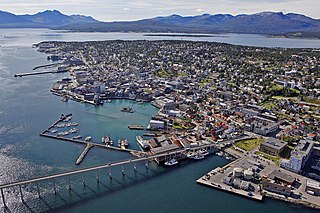| Ålesund Airport, Sørneset Ålesund sjøflyplass, Sørneset | |||||||||||
|---|---|---|---|---|---|---|---|---|---|---|---|
Luftwaffe Arado Ar 196 at the airport during the 1940s | |||||||||||
| Summary | |||||||||||
| Airport type | Private | ||||||||||
| Serves | Ålesund, Norway | ||||||||||
| Location | Sørneset, Ålesund | ||||||||||
| Elevation AMSL | 0 m / 0 ft | ||||||||||
| Coordinates | 62°28′07″N6°13′35″E / 62.46868°N 6.22640°E Coordinates: 62°28′07″N6°13′35″E / 62.46868°N 6.22640°E | ||||||||||
| Map | |||||||||||
| Runways | |||||||||||
| |||||||||||
Ålesund Airport, Sørneset (Norwegian : Ålesund sjøflyplass, Sørneset) was a water aerodrome and later heliport situated at Nørvevika and later Sørneset in Ålesund, Norway. The airport was, to a varying degree, used between 1929 and 1979. It has since been demolished.

Norwegian is a North Germanic language spoken mainly in Norway, where it is the official language. Along with Swedish and Danish, Norwegian forms a dialect continuum of more or less mutually intelligible local and regional varieties, and some Norwegian and Swedish dialects, in particular, are very close. These Scandinavian languages, together with Faroese and Icelandic as well as some extinct languages, constitute the North Germanic languages. Faroese and Icelandic are hardly mutually intelligible with Norwegian in their spoken form because continental Scandinavian has diverged from them. While the two Germanic languages with the greatest numbers of speakers, English and German, have close similarities with Norwegian, neither is mutually intelligible with it. Norwegian is a descendant of Old Norse, the common language of the Germanic peoples living in Scandinavia during the Viking Era.

A heliport is an area of land, water, or structure used or intended to be used for the landing and takeoff of helicopters, and includes its buildings and facilities. In other words, it is a small airport suitable for use by helicopters and some other vertical lift platforms. Designated heliports typically contain one or more touchdown and liftoff area and may also have limited facilities such as fuel or hangars. In some larger towns and cities, customs facilities may also be available.

Ålesund is a town and municipality in Møre og Romsdal County, Norway. It is part of the traditional district of Sunnmøre and the centre of the Ålesund Region. It is a sea port and is noted for its concentration of Art Nouveau architecture. The town of Ålesund is the administrative centre of Ålesund Municipality, as well as the principal shipping town of the Sunnmøre district.
Contents
The first use of Nørvevika was in November 1929 as a temporary base for the Royal Norwegian Navy Air Service. When Norwegian Air Lines commenced scheduled flights along the coast in 1935, they also took the facilities into use. The Navy Air Service returned in 1939 and decided to build a base, but there was no time to carry out the plans before the German invasion the following year. The Luftwaffe used the base for two Arado Ar 196 from 1941 to 1943, moving the base to Sørneset during the Second World War.

The Royal Norwegian Navy Air Service was alongside the Norwegian Army Air Service the forerunner to the modern-day Royal Norwegian Air Force.
Det Norske Luftfartselskap A/S or DNL, trading internationally as Norwegian Air Lines, was an airline and flag carrier of Norway. Founded in 1927, it operated domestic and international routes from 1935 to 1941 and from 1946 to 1951. It became one of the three founders of Scandinavian Airlines System (SAS) and became one of its three holding companies from 1951, with a 28% stake and listed on the Oslo Stock Exchange. DNL was renamed SAS Norge ASA in 1996 and was merged in 2001 to create the SAS Group.

Operation Weserübung was the code name for Germany's assault on Denmark and Norway during the Second World War and the opening operation of the Norwegian Campaign. The name comes from the German for "Operation Weser-Exercise", the Weser being a German river.
Lufttransport moved to the base in 1946 and carried out commercial flights in 1948 and 1949. After shutting down, these were taken over by Vestlandske Luftfartsselskap in 1950. They were retained until 1957, and the following season Ålesund Airport, Vigra opened. The final operator at Sørneset was Mørefly, who at first operated seaplanes and later focused on helicopters. They abandoned the site in 1979, moving to Vigra.

Ålesund Airport, Vigra is an international airport serving the town of Ålesund, Norway. It is located on the island of Vigra in Giske and features a 2,314-meter (7,592 ft) runway aligned 07/25. The airport served 1,077,209 passengers in 2013, making it the tenth-busiest airport in the country. Scheduled services are provided domestically to Oslo, Bergen and Trondheim by Scandinavian Airlines (SAS)¸ Norwegian Air Shuttle and Widerøe. International scheduled services are provided by Air Baltic, KLM Cityhopper, Norwegian, SAS and Wizz Air.

Mørefly A/S was an airline and general aviation company which operated between 1955 and 1995. Based in Ålesund and later Giske, Norway, it was involved in a wide range of operations, the most dominant being air ambulance services and helicopter services. Mørefly was based at Ålesund Airport, Sørneset until 1979 and thereafter at Ålesund Airport, Vigra. During its peak in the mid 1990s it had 150 employees and annual revenue of 250 million Norwegian krone (NOK).

A helicopter is a type of rotorcraft in which lift and thrust are supplied by rotors. This allows the helicopter to take off and land vertically, to hover, and to fly forward, backward, and laterally. These attributes allow helicopters to be used in congested or isolated areas where fixed-wing aircraft and many forms of VTOL aircraft cannot perform.





















